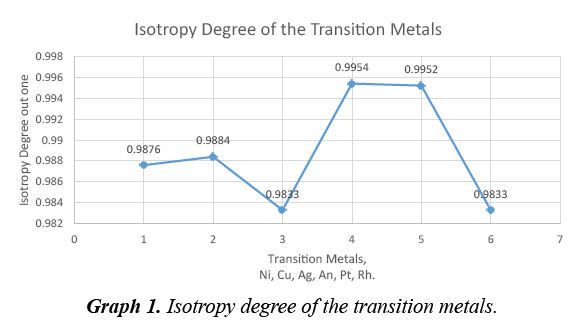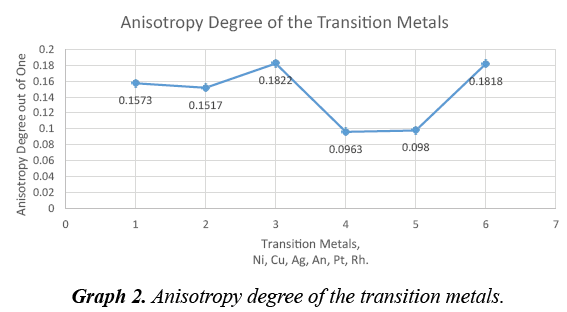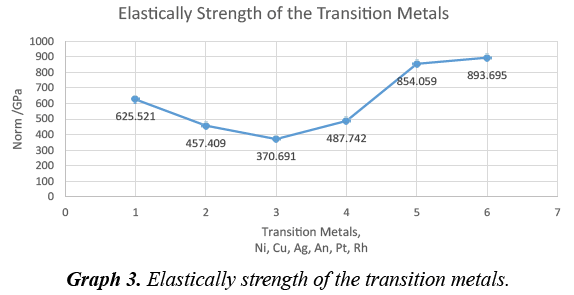Editorial - Materials Science and Nanotechnology (2017) Volume 1, Issue 2
Anisotropy of some FCC transition metals
Fae`q AA Radwan*Faculty of Engineering, Near East University, Turkey
- Corresponding Author:
- Fae`q AA Radwan
Faculty of Engineering
Near East University, Turkey
Email: faeq.radwan@neu.edu.tr
Accepted date: October 04, 2017
Citation: Radwan. Anisotropy of some FCC transition metals. Mater Sci Nanotechnol. 2017;1(1):13-14.
DOI: 10.35841/nanotechnology.1.2.13-14
Visit for more related articles at Materials Science and NanotechnologyAbstract
The norm of elastic constant tensor and the norms of the irreducible parts of the elastic constants of FCC elemental transition metals Nickel, Copper, Silver, Gold, Platinum and Rhodium are calculated. The relation of the scalar parts norm and the other parts norms and the anisotropy of these elements are presented. The norm ratios are used to study anisotropy of these elements
Keywords
Transition elements isotropy, Norm, Anisotropy, and Elastic constants.
Introduction
Anisotropy and Isotropy: when the properties of a material vary with different crystallographic orientations, the material is said to be anisotropic, common examples of anisotropic materials are wood and composites. Alternately, when the properties of a material are the same in all directions, the material is said to be isotropic.
The decomposition procedure and the decomposition of elastic constant tensor is given by Radwan [1], also the definition of norm concept and the norm ratios and the relationship between the anisotropy and the norm ratios are given by Radwan [1]. As the ratio becomes close to one the material becomes more isotropic, and as the ratio becomes close to one the material becomes more anisotropic as explained by Radwan [1].
Calculations
By using Table 1 and the decomposition of the elastic constant tensor, we have calculated the norms and the norm ratios as is shown in Table 2.
| No, | FCC, Transition Metal | C11 | C12 | C44 |
|---|---|---|---|---|
| 1 | Ni | 230.69 | 177.82 | 80.10 |
| 2 | Cu | 169.81 | 129.76 | 57.87 |
| 3 | Ag | 140.98 | 96.12 | 59.27 |
| 4 | Au | 179.42 | 147.38 | 41.64 |
| 5 | Pt | 313.99 | 257.92 | 73.69 |
| 6 | Rh | 339.62 | 232.29 | 142.58 |
Table 1: Elastic constants (GPa) [2].
| No. | FCC, Transition Metal | NS | Nn | NS | N |  |
 |
 |
|---|---|---|---|---|---|---|---|---|
| 1 | Ni | 617.738 | 0 | 98.37 | 625.521 | 0.9876 | 0 | 0.1573 |
| 2 | Cu | 452.118 | 0 | 69.371 | 457.409 | 0.9884 | 0 | 0.1517 |
| 3 | Ag | 364.488 | 0 | 67.529 | 370.691 | 0.9833 | 0 | 0.1822 |
| 4 | An | 485.476 | 0 | 46.962 | 487.742 | 0.9954 | 0 | 0.0963 |
| 5 | Pt | 849.949 | 0 | 83.687 | 854.059 | 0.9952 | 0 | 0.098 |
| 6 | Rh | 878.806 | 0 | 162.45 | 893.695 | 0.9833 | 0 | 0.1818 |
Table 2: The norms and norm ratios.
Conclusion
We can conclude from Table 2, and the above graphs
(Graphs 1-3) by considering the ratio  that Gold An, is
the most isotropic element, and the most anisotropic element
is Rhodium Rh, because the value of
that Gold An, is
the most isotropic element, and the most anisotropic element
is Rhodium Rh, because the value of  is the smallest and the value of
is the smallest and the value of  is the largest for Rhodium Rh,. Also we can
notice by considering the value of N that this value is the highest
(893.695) in the case of the Rhodium Rh element, so we can
say that Rhodium Rh is elastically the strongest, and the in the
case of the element Silver Ag (370,671) the value of N is the
smallest so we can say that Silver Ag, elastically is the least
strong element [2].
is the largest for Rhodium Rh,. Also we can
notice by considering the value of N that this value is the highest
(893.695) in the case of the Rhodium Rh element, so we can
say that Rhodium Rh is elastically the strongest, and the in the
case of the element Silver Ag (370,671) the value of N is the
smallest so we can say that Silver Ag, elastically is the least
strong element [2].


